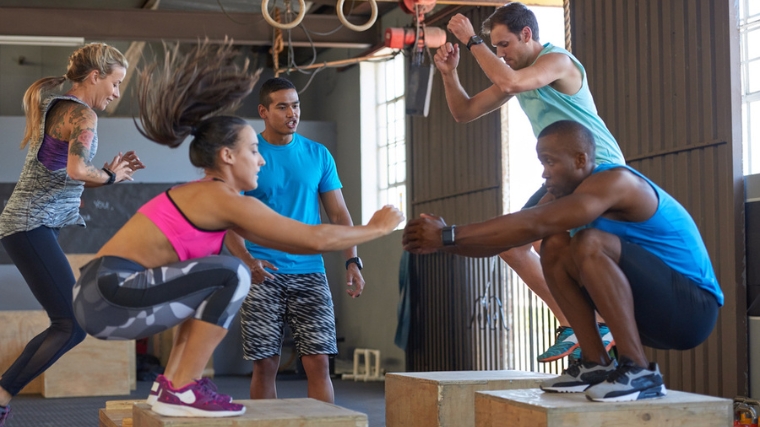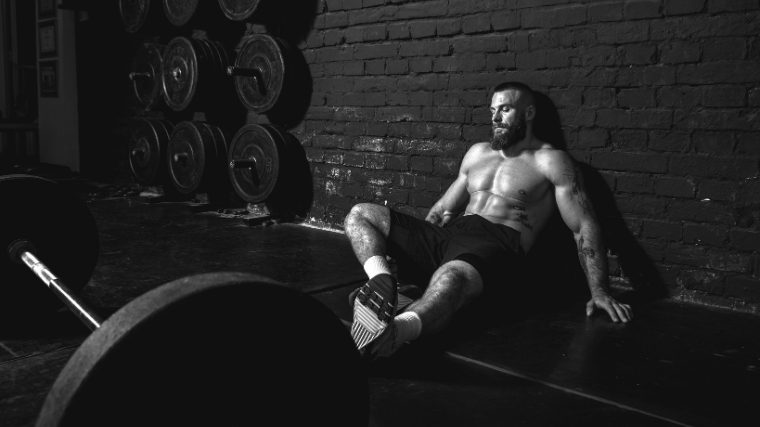If you’re a CrossFitter, you probably don’t put a high premium on taking it easy. The nature of a good CrossFit WOD — that’s the workout of the day for the uninitiated — is to test the limits of your physical and mental fitness. How hard are you willing to push today? That’s generally the question at hand.
But the limit does, in fact, exist. Especially with such a high-intensity sport, taking breaks is just as important as going unbroken in that final round of double-unders. Without locking in fundamentals like CrossFit nutrition and regularly-scheduled off-seasons, you’re likely to sprint face-first into burnout.

It might not be the most popular topic to bring up in a CrossFit box, where so much focus is on the importance of showing up and finishing what you start. But when that nagging lack of motivation kicks in, you might have to shift gears, slow down, or even stop completely. Here’s how to avoid burnout in CrossFit — and how to identify it when it’s already set in.
Editor’s Note: The content on BarBend is meant to be informative in nature, but it should not be taken as medical advice. When starting a new training regimen and/or diet, it is always a good idea to consult with a trusted medical professional. We are not a medical resource. The opinions and articles on this site are not intended for use as diagnosis, prevention, and/or treatment of health problems. They are not substitutes for consulting a qualified medical professional.
What Is Burnout in CrossFit?
Burnout in CrossFit can refer to any number of performance-diminishing factors, ranging from lack of motivation to physical plateaus. You might not want to work out at all, or you might specifically want to avoid CrossFit workouts in favor of other options or even some well-deserved rest.
For those who are heavily involved in a CrossFit community, this might also manifest as avoiding gym-related social commitments or engagements. If you’ve been very involved with your CrossFit box’s community, burnout may also be accompanied by social pressure to keep you coming back consistently.

Burnout doesn’t always stem from a physical place, though. The culture of CrossFit focuses on community and welcoming members with various life and fitness experiences. Still, if you find yourself feeling isolated from the community at your box for whatever reason, it can definitely create a lack of motivation to continue.
Signs of Burnout in CrossFit
Burnout looks different for everyone. But in general, here are some signs to look out for:
- Lack of motivation
- Fatigue
- Avoidance of gym-related social engagements or events
- Dreading workouts
- Not having fun during workouts
- Coming up with reasons to avoid your CrossFit box
- Feelings of resentment toward your box or the sport
- Persistent sense of loneliness or isolation at your gym
- Dissatisfaction with your body image (1)
Burnout Vs. Overtraining
Sometimes, burnout is a colloquial phrase for being overextended, exhausted, and unmotivated. But burnout may also refer to feeling restless or depressed. In the context of training, it may manifest in not wanting to work out or even dreading your training.
Other times, burnout is meant to refer to something specific physiologically. Overtraining syndrome refers to the sensation of persistent sluggishness, reduced performance, and even mood swings like irritability and depression. Overtraining typically impacts your life beyond your training, complicating even day-to-day tasks unrelated to your program.

Let’s be clear — you can feel burnt out without having reached the level of physiological overtraining. Elements of overtraining may also be part of oncoming burnout, and they can easily blend into each other. If you’re concerned about the state of your body and mind, you might want to check in with a doctor.
Burnout and Overtraining Vs. Overreaching
Overreaching is one of the cornerstones of CrossFit. The term refers to a short period of time during training when you go all out — this might mean heavy load, increased volume, or otherwise high intensity. In order to complete most WODs, you generally need to overreach.
Overtraining syndrome comes from chronic overreaching. (2) If you train at such a high intensity over long periods of time without adequate recovery, you may be setting yourself up for experiencing overtraining syndrome. In a well-designed program, you’ll make sure to cycle periods of overreaching with lower-intensity training blocks to avoid overtraining.
And while tactically overreaching is precisely the path to success in CrossFit, it might also be the reason behind your feeling burnt out and unmotivated to work out. If you’re stacking up max-effort WOD atop max-effort WOD — especially without adequate recovery for both body and mind — you might be setting yourself up for burnout.
Symptoms of Overtraining Syndrome
Ideally, you want to prevent burnout or overtraining from occurring in the first place. But if you suspect that burnout is closer than you’d like it to be, it pays to be diligent and proactive. Symptoms of overtraining syndrome include the following: (3)
- Loss of motivation
- Fatigue
- Depression
- Hypertension
- Bradycardia
- Tachycardia
- Restlessness
- Irritability
- Insomnia
- Disordered eating habits
- Lack of mental focus
- Sore and stiff muscles
- Anxiety
Some research suggests that physiological changes to your nervous system and hormone levels may be behind these symptoms. (2)(3) Other research suggests that true overtraining syndrome may be rare in strength sports and resistance training — though more research is needed into the phenomenon’s occurrence in CrossFit. (4)
Strategies to Avoid Burnout in CrossFit
To survive intense WODs, you know you need to push through one rep at a time. But to survive training from week to week and year to year, you need to think long-term. Here are some ways to prevent burning out in CrossFit.
- Focus on Sleep
- Eat Enough Food
- Check In With Your Community
- Take Unscheduled Days Off
- Scaffold in an Off-Season
- Periodize Your Training
- Program Regular Deloads
- Take a Break From WODs
- Mix Up Your Schedule
- Do Your Favorite WODs
Focus on Sleep
It’s all too easy to underestimate how important sleep is for the sport of CrossFit. But there’s a reason CrossFit legends from Brooke Wells to Noah Ohlsen are sponsored by WHOOP, a fitness wearable that focuses on monitoring your sleep.
Without adequate sleep, there’s just no way you’re going to be able to sustain the level of intensity that CrossFit requires. Both mentally and physically, you need to be at the top of your game if you have a shot at avoiding burnout in this sport. Getting at least seven to nine hours of sleep each night is a solid baseline to start from.
Eat Enough Food
CrossFit requires a lot of fuel. Whether you’re burning through a quick six-minute WOD or trudging your way through Murph, your body needs to get its energy from somewhere. CrossFitters tend to be a fan of their supplements — over three-quarters of CrossFitters in one study reported taking at least one supplement. (5) The most popular among these athletes seemed to be protein, creatine, or a pre-workout.
But it’s about much more than just supplements. CrossFitters also may run the risk of micronutrient deficiencies, so it’s critical for maintaining both energy levels and overall health to eat a wide variety of food in adequate amounts. (6)
If you’re like anything like four-time America’s Fittest Woman® Kari Pearce, you might opt to take an intuitive approach to your nutrition. Let your hunger levels guide how much and when you eat. Just make sure you’re getting a wide spread of macronutrients (protein, carbs, and fats) to fuel performance.
Emphasize protein for muscle growth, but also consider keeping your carb levels relatively high to fuel those powerhouse performances. For athletes who benefit from tracking their macro intake, here’s BarBend’s macronutrient calculator to help you determine how much you need.
Macronutrient Calculator
If it’s safe for you to count calories and you’re unsure of just how many calories your body needs to fuel your CrossFit endeavors, check out BarBend’s calculator.
Calorie Calculator
Athletes that are feeling burnt out might find that they need to eat more food — or different kinds of food — to fuel the kinds of workouts they want to do. Check in with a doctor or licensed nutritionist to make sure your dietary habits are supporting your goals in the gym.
Check In With Your Community
Are you getting everything you need from your CrossFit community? If you’re not able to feel completely at home in your box, it can easily create a disconnect between you, your gym, and your workouts. Especially when everyone around you seems to feel perfectly comfortable in a fitness space, feeling isolated in the first place can be even more alienating.
CrossFit often becomes part of an athlete’s identity, so feeling out of place in that identity can have serious impacts on motivation. If you don’t feel settled in your CrossFit box and it’s impacting your motivation or sense of self, it might be time to make a hard decision. You may need to assess whether it’s worth it to you to seek out a more affirming environment.
Take Unscheduled Days Off
You don’t always have to force yourself to go to the gym when you don’t feel like it. CrossFit requires a tremendous amount of mental energy. You don’t only have to show up — you have to power through unpredictable and extraordinarily taxing workouts. The toll it takes on your brain can be high.
If you need to take a mental pause, spend extra time in bed, or go on a spontaneous trip with your family, do it. One of the fastest ways to burn out in CrossFit is to develop resentment toward the sport if you feel like it’s taking away from the rest of your life. So don’t be afraid to take off when you need to if doing so helps maintain your longevity in the sport.
Physical stiffness and soreness are also valid reasons to take a stroll on the beach instead of tearing it up in the gym. It doesn’t have to be a programmed off day for you to stay home.

Excessive fatigue, muscle soreness, and shortness of breath are all very common after CrossFit workouts. Research suggests that not recovering adequately from your WODs may put you at higher risk for severe injuries like exertional rhabdomyolysis, which is a breakdown of muscle tissues that can put your heart and kidneys in jeopardy. (7)(8)
So if you’re sore and tired or having trouble breathing, sometimes you’ll still decide to push on and do your WOD. But doing that time after time may set you up for more than burnout — you might also risk injury. Don’t be afraid to take those days off, even if you’re technically able to work out.
Scaffold in an Off-Season
If you’re a competitive CrossFitter, you have a season naturally built into the year. This will help give your months natural peaks and valleys of intensity that can help keep you motivated and eager for what comes next.
Even if you don’t compete in the Open, programming a personal off-season is vital for your physical and mental health. The pros don’t go all out for 12 months out of the year, and neither should you.
The beautiful thing about not competing is that you can design the off-season for yourself. Maybe you’re welcoming a baby into the family and know you’ll want as much time as possible away from the gym once the baby comes. Or maybe your family likes taking summer vacations together, or you know tax season is especially intense at work.

Whatever the situation that will have you wanting to spend less time in the gym, plan for it in your program. By customizing your own off-season, you’ll be packing in as much “you” time as possible into your year. Avoiding burnout is often about being a well-rounded person (not just a well-rounded athlete), and giving yourself an off-season can help you do just that.
Periodize Your Training
Deploying progressive overload in your training does not mean that you continue slapping weight on the bar or otherwise increasing intensity without pause. In a well-designed program, progressive overload needs to exist in a periodized context — that is, there need to be ebbs and flows of intensity in your training.
Part of this involves including an off-season, but periodization is about shorter-term thinking, too. Break your program down into different training cycles or blocks, each emphasizing a different goal, skill, or training modality. For example, you might spend six weeks mainly working on relatively heavy weightlifting. After a week-long deload, you may transition into an eight-week hypertrophy and skills block.
If you’re following the programming at your local box, check in with your coach about what you can expect from week to week and month to month. Periodization can help you avoid boredom while still progressing strategically with your training. That way, if you’re getting bored and antsy in week six of a cycle, you can look forward to that fresh start in a couple of weeks.
Program Regular Deloads
Every four to 12 weeks, periodization often calls for a deload week (or two). Depending on the intensity of your training, you might need longer deload weeks more often. For some, deload weeks mean an entire week off from training. You might go on long walks or take some low-intensity yoga classes in lieu of your typical WODs.
In other cases, a deload week might mean simply reducing the intensity of your typical training. You might use less weight than prescribed, or you might move slower through your timed WODs than you normally would. You may also choose to focus on skills training during deload weeks, focusing on technique — in the snatch or handstand walks, for example — as opposed to load.
Deloading is a critical part of every program. It will help you avoid overtraining your body and help keep your mind sharp. When you’re deloading, you’ll give yourself the chance to get excited about tougher workouts instead of dreading the daily slog.
Take a Break From WODs
You don’t have to do the WOD that everyone else is doing to be a “real” CrossFitter. If you need to head to your box at open gym time to work out on your own, do it. You might even opt for a different commercial gym to focus entirely on other strength sports for a time. There is, after all, a tremendous crossover between weightlifting, strongman events, and CrossFit.
If there’s tension in your box because you’re working out on your own instead of in classes, it might be time to take a step back from your box entirely. While leaving or changing boxes can be disorienting — to say the least — for dedicated CrossFitters, it might be a good choice if you’re feeling less support amid oncoming burnout.
That said, taking a break from your WODs doesn’t have to mean up and leaving. You can pop back into your usual classes whenever you’re feeling motivated again.
Mix Up Your Schedule
Been taking the same Wednesday, Friday, and Sunday morning classes throughout the entire year? If your CrossFit routine is starting to get stale, shake it up.
Take different classes, or take classes at unusual times of the day. Even if you’re a morning person, you might find out that you actually enjoy heading to your box after work. It might give you a fresh training stimulus, a different group of people working out with you, and a new lease on your motivation to keep showing up.
Do Your Favorite WODs
In CrossFit, there’s an emphasis on practicing what you’re not good at. And with good reason — WODs are designed to help you be as well-rounded an athlete as possible. You never know what you’re going to get, and any workout can combine weightlifting, gymnastics, or monostructural movements.
To make sure you can conquer anything from heavy snatches to ring muscle-ups, you have to give a lot of energy to the moves you hate doing. But if you’re cruising toward burnout, give yourself the grace to focus on what you like instead. Instead of forcing yourself through skills work you hate, spend some time doing the workouts you love.

Let yourself focus on what you like most about CrossFit. It might help stave off that lack of motivation and remind you how much you love your sport. That could be exactly what you need to prevent oncoming burnout.
More on CrossFit Training
Whether you’re in the midst of an intense WOD or an intense season, pacing yourself is just as important as pushing yourself in CrossFit. If you’re fighting off a lack of motivation, try the above tricks and tips to help you get that old spark back.
If you’ve done your due diligence to avoid burnout in CrossFit, you might well be itching for even more articles on the topic. Here’s some more essential CrossFit reading.
- The 12 Best Leg Exercises for CrossFitters for Strong, Powerful Legs
- The 12 Best Arm Exercises For CrossFitters
- The 10 Best Core Exercises for CrossFit to Help You Crush Your Next WOD
References
- Baella-Vigil GV, Hurtado-Bocanegra M, Marroquín-Quintana J, Rojas-Fernández MV, Rosales-Medina JM, Urbina-Rodríguez JC, Tarabay-Barriga AP, Carreazo NY. Burnout syndrome in athletes and their association with body image dissatisfaction at a private university. J Sports Med Phys Fitness. 2020 Apr;60(4):650-655.
- Cadegiani FA, Kater CE. Novel insights of overtraining syndrome discovered from the EROS study. BMJ Open Sport Exerc Med. 2019 Jun 20;5(1):e000542.
- Kreher JB, Schwartz JB. Overtraining syndrome: a practical guide. Sports Health. 2012 Mar;4(2):128-38.
- Bell L, Ruddock A, Maden-Wilkinson T, Rogerson D. Overreaching and overtraining in strength sports and resistance training: A scoping review. J Sports Sci. 2020 Aug;38(16):1897-1912.
- Brisebois M, Kramer S, Lindsay KG, Wu CT, Kamla J. Dietary practices and supplement use among CrossFit® participants. J Int Soc Sports Nutr. 2022 Jul 4;19(1):316-335.
- Gogojewicz A, Śliwicka E, Durkalec-Michalski K. Assessment of Dietary Intake and Nutritional Status in CrossFit-Trained Individuals: A Descriptive Study. Int J Environ Res Public Health. 2020 Jul 2;17(13):4772.
- Drum SN, Bellovary BN, Jensen RL, Moore MT, Donath L. Perceived demands and postexercise physical dysfunction in CrossFit® compared to an ACSM based training session. J Sports Med Phys Fitness. 2017 May;57(5):604-609.
- Knapik JJ. Extreme Conditioning Programs: Potential Benefits and Potential Risks. J Spec Oper Med. 2015 Fall;15(3):108-113.
Featured Image: Jacob Lund / Shutterstock